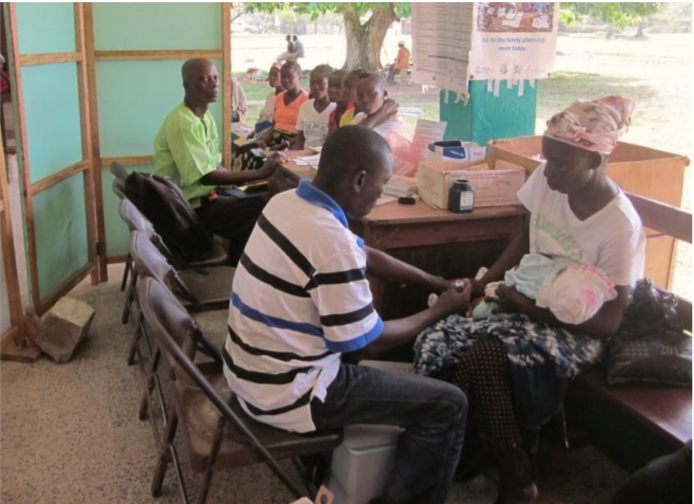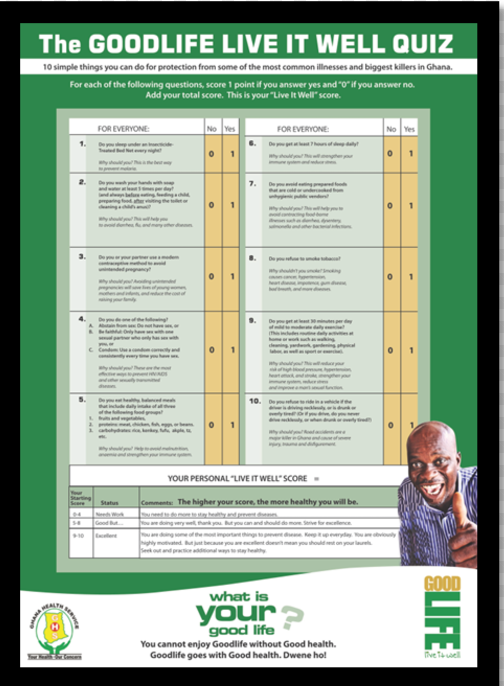Components
Target Audience
Integrating SBCC can complicate audience identification and segmentation. It might also reveal overlooked audiences. It is important to use what is known in the literature and discovered during formative research to identify and prioritize audiences, understanding that priority and influencing audiences might differ according to the topic or behavior.
If using an umbrella approach, you may find there is a core audience for the overarching brand, and more specific, segmented audiences for each technical intervention. Ghana’s GoodLife “umbrella” brand, for example, targeted young families. The specific target audience would then vary slightly for each different health campaign. For example, pregnant women were a primary target audience and mothers/mother-in-laws were a secondary target audience for the IPTp campaign.
Integrated SBCC may be particularly relevant for certain audiences, such as adolescents as the focus of a reproductive health project, who would need (and likely welcome) information not only about contraceptives but also about sexual debut, marriage, education, livelihoods, HIV and more.
Consider what types of audience segmentation might make sense for your integrated SBCC program. If you are using a Life Stages approach, you may segment by key life stages, such as adolescence, marriage, pregnancy and parenthood. Some of these stages can be broken down even further, depending on the program’s needs. Parenthood, for instance, may include the pregnancy period, parents of newborns, parents of infants and parents of children ages two to five -years old. If your program is grounded in the Stages of Change, you may look to segment by readiness to adopt a behavior. As multiple behaviors are implicated in integrated programs, a “readiness index” that assesses the stage of change across all behaviors might be appropriate. Possibilities for audience segmentation are nearly endless. See How to Do an Audience Analysis and How to Do Audience Segmentation for more information.
On the other hand, you may find a need to collapse target audiences into broader categories in order to achieve efficiencies. Be prepared to lose the specificity of your target audience in order to gain effectiveness.
Program Experience
(When you see a Program Experience, simply click on the photo to read insights from real integrated SBCC programs.)
Content and Messaging
When developing content for an integrated program, it is particularly important to think about how you will prioritize and package the content. In other words,
- Prioritize: Which health topics or behavioral messages will be rolled out first? Which will be rolled out last? How much time will be given to each topic area? Which content is most important and absolutely must be included in the program? Which content might be cut?
- Package: Which health topics will be bundled together? Which behavioral actions might be combined within one message?
Program Experience
How to Prioritize and Package Content
Deciding how to prioritize or package content for an integrated SBCC program can be complicated. Which content do you keep? What do you sacrifice for the sake of focus? What do you focus on first? Do certain topics or behaviors deserve more attention than others? How do you ensure your messages are well-balanced, coherent, logically packaged and rolled out in an understandable way?
Programs have used a variety of approaches for prioritizing and packaging content in integrated strategies. As noted above, some use a phased approach, which helps balance the amount of information being conveyed at once. For example, a phased approach can start with messages about behaviors considered to be relatively easy to adopt (i.e., “low-hanging fruit” or small, doable actions), as determined by formative research, or with the topic whose funding ends first/earliest. If possible, plan to repeat the cycle of messages to reinforce them. Unfortunately, in situations where multiple donors or vertical programs are involved, phasing can be difficult.
Ultimately, you are aiming to create synergy by addressing related topics together. Consider the following methods of combining or prioritizing SBCC content.
Guidelines from the Africa Biodiversity Collaborative Group on freshwater conservation and WASH integration recommended the following widely applicable lesson: “Resist the urge to design a 50/50 project between WASH and freshwater conservation activities and do not be afraid to rule things out. Projects are context specific. Not all implementation elements can be incorporated for many reasons including lack of financial resources, capacity, community ownership or other constraints. No project can do everything, what matters most is that the project achieves the agreed upon goals.” (Edmond, et al., 2013)
Tip
When it comes to SBCC integration, focus demands sacrifice – even more so than in vertical programs. In deciding how many messages to convey in a single intervention, such as a counseling session or radio drama, consider both the audience and the channel. Some research shows people can retain just three key messages discussed in a 15-minute session.
Program Experience
Message Harmonization
While messages are an integral part of your communication strategy and will be addressed during the strategy design, you may find you need to dedicate extra time to this component.
Hold a message development workshop with partners and stakeholders to help ensure messages are harmonized and agreed upon. Also ensure that partners feel their messages are represented well.
- Organizing this workshop may best be assigned to a working group, task force or other sub-group of the coordinating body.
- Be sure to include technical experts from each topical area in the workshop to help ensure technical accuracy.
- Consider developing a message guide or matrix to harmonize all messages moving forward.
See the HC3 guide on How to Design SBCC Messages. The list of Resources at the end of this section provides examples of how integrated SBCC projects have harmonized messages.
Program Experience
Channel Selection
As with any SBCC program, the choice of channel(s) should depend on the audiences, the purpose/desired outcome and the type of information being conveyed. Similarly, it is important to ensure message consistency across all channels. See HC3’s guide on how to develop a channel mix plan here.
Tip
Studies of integrated SBCC projects found IPC to be highly effective when communicating multiple messages. One key is to ensure that those delivering the messages exercise critical thinking skills and can tailor messages to the individuals with whom they interact/to each client, based on client needs.



 Content and Messaging
Content and Messaging
 Message Harmonization
Message Harmonization